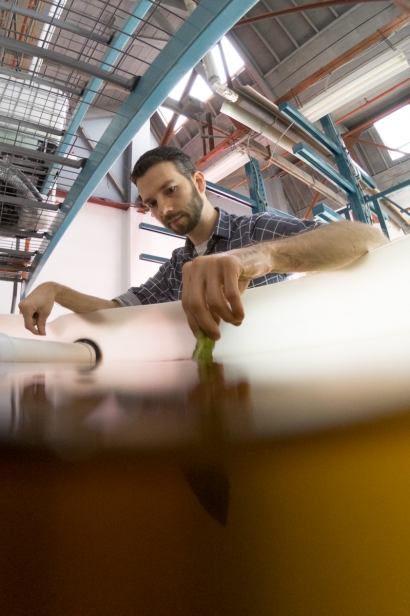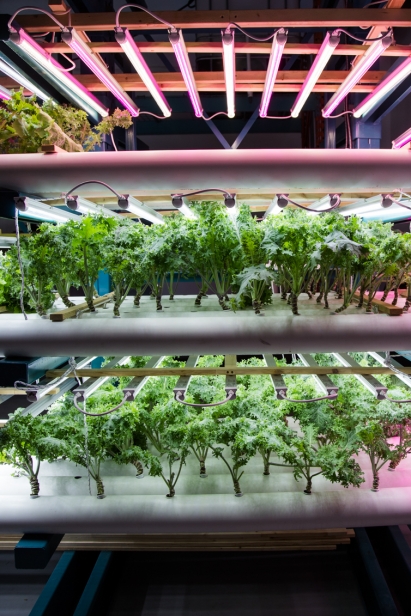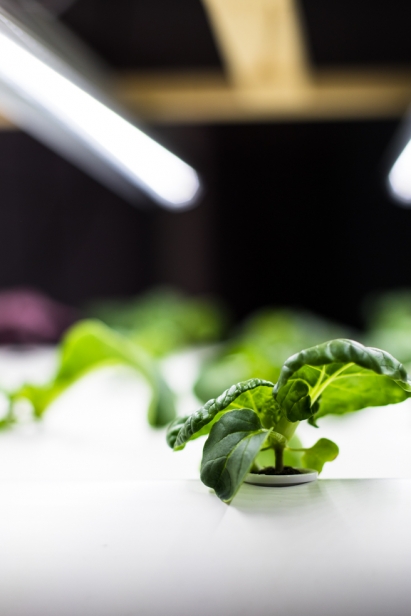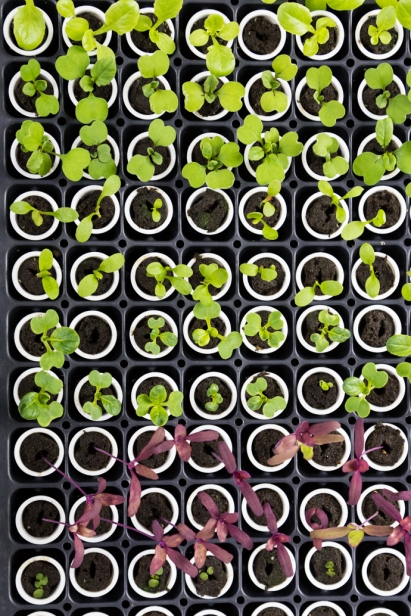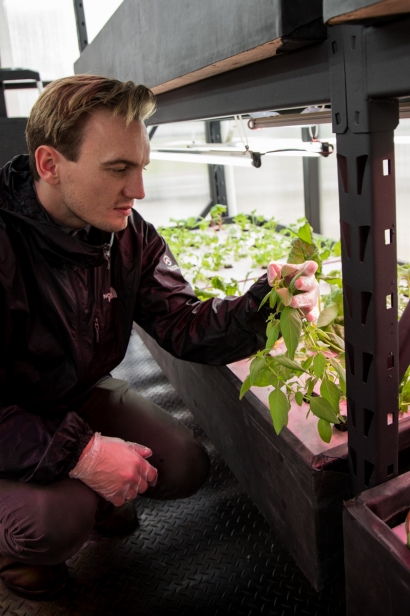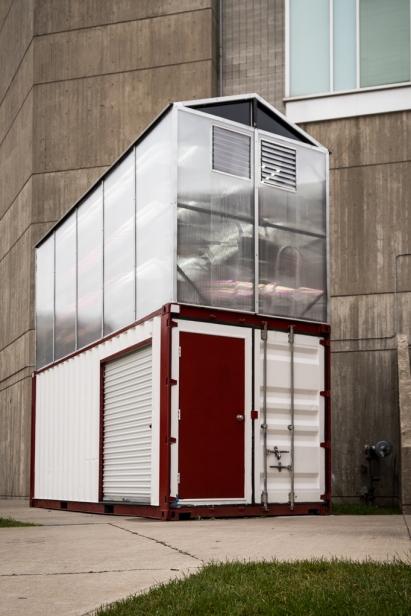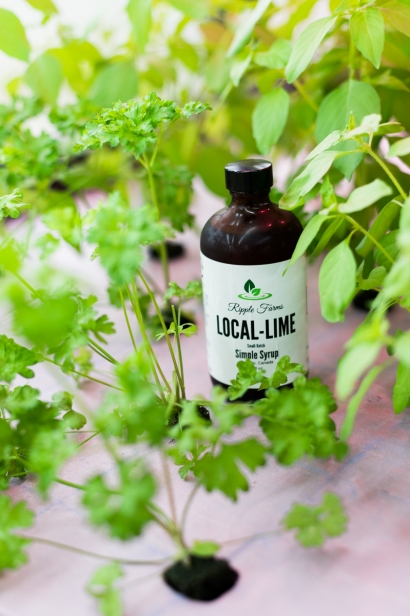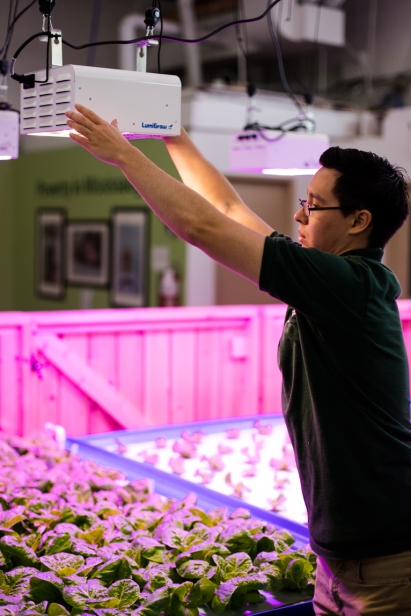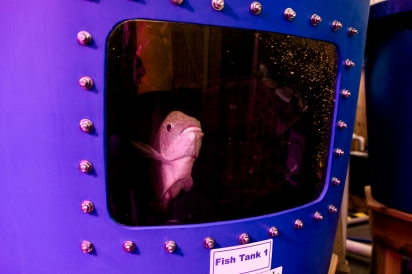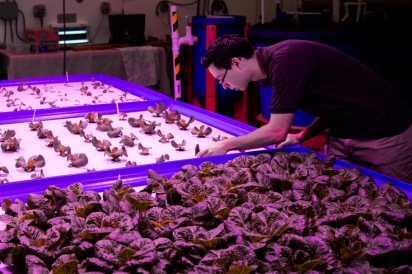A City That Feeds Itself
The space at Waterwheel Farms looks more like something you would find inside a NASA research lab than an urban farm located in downtown Toronto. But despite its futuristic and sterile look, the farming practices being carried out inside the 1,000-square-foot space have origins dating back hundreds of years.
Aquaponic farming is a combination of aquaculture (the farming of fish and other aquatic organisms) and hydroponics (the process of growing plants in sand or water without soil.)
The process is simple and doesn’t have many moving parts. Essentially, the fish eat and excrete and that nutrient-rich water is used to grow vegetables and greens. The plants absorb the nutrients, which helps purify the water. The water is then poured back into the fish tank, aerating as it hits the surface.
Often times, wilted or unused greens are fed back to the fish, making the process a closed-loop ecosystem.
Though the term itself was only coined in the late 1900s, aquaponic farming is believed to have roots dating as far back as the Aztec empire in Mexico around 1300 AD, where artificial floating islands — known as chinampas — were used to grow various plants. There is also record of fish living harmoniously with rice cultivars in paddy fields in parts of south China and Thailand, dating back to the first century AD.
Though the exact ancient origin of aquaponics may be up for debate, one thing is certain — what’s old is new again.
Waterwheel Farms
The rise of aquaponic farming has been slow yet steady in Toronto. There are now a handful of farms operating in the city, but it’s a number Alec Wheeler, founder and CEO of Waterwheel Farms, expects to grow.
“More and more of us are moving to urban centres and we can’t bring the traditional farm with us,” he quips. “With the growing desire for cities to become self-producing and sustainable, it’s clear we need an efficient form of farming.”
Though the look and design of a modern-day aquaponic system is drastically different from the one ancient civilizations used centuries ago, some of the benefits remain the same.
It uses less water than traditional agriculture — as much as 90 per cent less, according to Wheeler. And there is no toxic runoff that could pollute surrounding ecosystems.
You can get year-round production and faster growth cycles. For example, some salad types can take as few as three weeks to reach full maturity and be ready for harvest. This means Wheeler can harvest his kale 17 times in one year, compared to just one to two harvests on a traditional farm.
For many aquaponic converts, the fact that the farming method produces the purest form of organic greens — since using pesticides or herbicides would kill the fish and microbes needed for the ecosystem to survive — is one of the biggest selling points.
Wheeler, who calls himself “a bit of a futurist,” says for the human race and planet to thrive, we need to find solutions to three hurdles: energy, transportation and food.
He’s helped tackle the first two over the last 10 years in his job as a corporate account manager at Bullfrog Power, a renewable and green energy company.
But his first experience with aquaponic farming started in his living room, about six years ago. An aquarium filled with tilapia stood in place of his coffee table. Pipes and tubing extended out to the wall to irrigate greens.
“I was tired of purchasing produce that often ended up being thrown out because I couldn’t eat it fast enough,” he says. “I wanted something I could harvest as needed.”
After doing some research, he was hooked, but still had the same problem. “I was now growing more greens than I could use,” he says. That’s when the concept behind Waterwheel Farms was born.
Wheeler rents a unit in an industrial building near Dufferin Avenue and Queen Street West, parts of which date back at least a century, according to markings on the bricks. It claims to also be one of the last original saw-tooth roof buildings left in the city — which Wheeler calls the “original form of energy efficiency.”
The design allows for Wheeler’s farm to use natural sunlight for the majority of the lighting. In fact, Wheeler likes to give nature a lot of the credit for aquaponic farming.
“You never see nature create fields like in agriculture … but you do see fish, plants and microbes living together every time you look at a lake or an ocean,” he says, adding that all his plants start from heirloom or organic seeds.
“Aquaponics is simply a form of biomimicry where Mother Nature really deserves all the research and design credit."
Ripple Farms
For Steven Bourne, the journey to aquaponic farming was what he calls a romantic story — a serendipitous meeting between he and his co-founder of Ripple Farms. Both Bourne and Brandon Hebor studied sustainable business management at Seneca College — but never met while at school. It wasn't until after graduation that they were brought together by a mutual friend to work on another project.
After a meeting, Hebor showed Bourne his home-based aquaponic set-up, and that’s when Bourne says “a light bulb went off” in his head. At the next meeting, he showed Hebor a business plan — the framework for what Ripple Farms is today.
Ripple currently operates a 160-square-foot aquaponic operation out of Seneca College, but its very first farm was located at the Evergreen Brickworks. That farm underwent an overhaul and redesign in recent months and is expected to reopen early this year.
Like Waterwheel, Ripple raises tilapia, but Bourne hopes to move to a more local species in the future. Both farms are certified by Ocean Wise, assuring the consumer that the fish is a sustainable and ocean-friendly choice.
For Bourne, the biggest selling feature of aquaponics is that it can showcase sustainable innovation in urban areas such as Toronto.
“Our 30,000-foot goal is to contribute to eliminating food insecurity in Canada, then the world,” he says. But the more immediate goal is to “bring the farm to the city to reconnect people to food,” he adds.
Education is key to help drive systemic change in the city and “encourage people to grow more at home, cook more at home and improve the values around food and farming.” Bourne and Hebor welcome school groups for tours and offer courses featuring industry experts for those who want to learn about the process.
But as with any startup and new business venture, there are challenges. Though Bourne acknowledges there’s been a lot of progress around urban agriculture, one of the greatest barriers is the zoning of land for agriculture use — not to mention property prices, especially in a city such as Toronto.
He says there is also a lack of knowledge around aquaponic farming, citing that building owners are often uncomfortable when they hear the term "vertical farming" or about fish being involved.
That said, Bourne believes the future will only attract more attention to aquaponics as the pressure for internalized food production continues to grow.
“With food prices in Canada rising at five per cent year over year, the 10-year forecast isn’t looking good for young people who can barely afford rent,” he says. As a result of rising food costs and rents, the use of food banks in Toronto has also been on the rise.
AquaGrow Farms: The Mississauga Food Bank
You may think of food banks as dusty places, where dented cans of food gather en masse in warehouse-like spaces, but there is innovation happening behind the scenes.
The Mississauga Food Bank is one of the first in Canada to introduce an aquaponic farm as a means of getting fresh produce and protein to its clients.
AquaGrow Farms has been operating for a little more than a year inside a 500-square-foot space at the food bank, which is funded mostly by public donations. During that time, they’ve been able to harvest nearly 11,000 servings of greens, including romaine lettuce, swiss chard, spinach and bok choy. They've also produced more than 600 servings of tilapia.
For Chris Hatch, executive director of the food bank, starting an aquaponic farm was born out of necessity. In Mississauga, there is “no access to agriculture [and there are] no more farms close by,” he says and adds that “produce donations are declining.”
For Hatch and Colin Cotton, AquaGrow Farms supervisor, educating the public about sustainable urban farming is an important part of the venture.
But nothing in their own education prepared them to become aquaponic entrepreneurs. Hatch’s background is in management consulting and Cotton’s is in psychology. They call themselves “grassroot farmers” who learned everything there is to know about aquaculture and hydroponics from being “passionate” about the idea.
Since opening the farm, Hatch says they’ve received calls from food banks in Africa and Germany.
“It’s a great thing to connect with international colleagues; we can talk challenges and openly share information,” says Cotton.
The plan to expand in the same location is in the immediate works, but in the long term, Hatch hopes to open more farms around the city.
With traditional farming land disappearing in the Greater Toronto Area as a result of urban sprawl, one thing is certain — change is inevitable.
As the options for fresh, local produce continue to dwindle, aquaponics may be the non-traditional solution a city such as Toronto needs.
Waterwheel Farms
442 Dufferin Street Unit B., Toronto, Ont.
waterwheelfarms.ca, 416.841.5704
Ripple Farms
550 Bayview Ave., Toronto, Ont.
ripplefarms.ca, 647.921.7495
AquaGrow Farms (The Mississauga Food Bank)
3121 Universal Dr., Mississauga, Ont.
aquagrowfarms.ca, 905.270.5589



